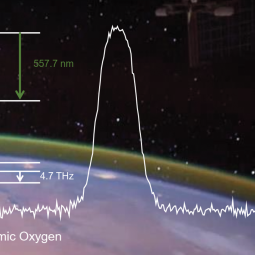By Heinz-Wilhelm Hübers and Joan Schmelz
Paper:
Direct measurements of atomic oxygen in the mesosphere and lower thermosphere using terahertz heterodyne spectroscopy
Richter, Heiko, et al., 2021/12, Communications Earth & Environment, 2, 19.
Atomic oxygen, an important player in climate-change models, has been measured directly for the first time in one of the least understood regions of Earth’s upper atmosphere — the mesosphere and lower thermosphere. These results from SOFIA help solidify some of the basic science around how solar energy is exchanged between the Earth’s surface and space.
Since atomic oxygen plays an important role in cooling the upper atmosphere, it is used to estimate temperatures in this region. Climate models predict that increasing greenhouse gases will raise temperatures in the lower atmosphere yet decrease temperatures in the upper atmosphere, particularly in the mesosphere and lower thermosphere. But this region is difficult to study — ground-based telescopes are hampered by distortion from water vapor, satellites can infer levels of oxygen but cannot make direct measurements, while rockets and the space shuttle offered only brief snapshots of this region.
Atomic oxygen governs the photochemistry and the energy balance of the mesosphere and lower thermosphere. In addition, it can be used as a tracer for dynamical motions. Concentrations can be inferred indirectly from the oxygen air glow or from observations of hydroxyl. Such measurements have been performed with several satellite instruments, but the methods rely on photochemical models and assumptions such as quenching rates, radiative lifetimes, and reaction coefficients. As a consequence, the results are not always in agreement, particularly when obtained with different instruments.
Researchers have now explored an alternative approach, namely the observation of the 3 P 1 → 3 P 2 fine-structure transition of atomic oxygen at 4.7 THz (63 µm) using the GREAT heterodyne spectrometer on SOFIA. With its high spectral resolution and sensitivity, GREAT enables unique measurements, both astronomical and atmospheric. This method has the advantage of measuring atomic oxygen directly, without involving photochemical models, because the populations of the states involved in this transition are determined solely by temperature and quantum mechanics. The line profile is Doppler broadened and varies between approximately 10 and 30 MHz depending on the altitude from where the emission originates. This means that the altitude information of the atomic oxygen concentration is contained in the line profile.
The atmospheric data are a by-product of astronomical observations in the same frequency band. The signal from the astronomical object is significantly Doppler shifted (up to ~3 GHz) from the atmospheric line, so they can be readily separated. Astronomers have always treated the atmospheric data as contamination and filtered it out from the sought-after celestial signal. While researchers saw that the atmospheric data could itself be valuable, it took several years to develop the right tools and processes to calibrate and analyze it.
For analysis of the spectra, researchers developed a radiative transfer code based on atomic oxygen concentration and temperature profiles from a semi-empirical model and satellite measurements. The expected atomic oxygen emission was modeled and compared with the emission measured by GREAT. The agreement was quite good, with differences within the uncertainty.
A trove of atomic oxygen data from many seasons and locations obtained with GREAT and upGREAT already exists in the SOFIA data archive. upGREAT adds the fine-structure transition at 2.06 THz. The SOFIA measurements are an important step towards a conclusive understanding of the Earth’s upper atmosphere and reliable confirmations of climate model predictions.

